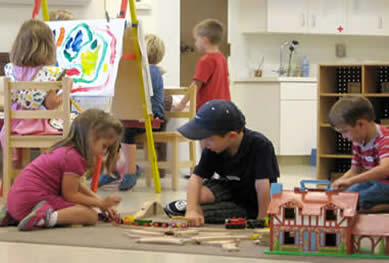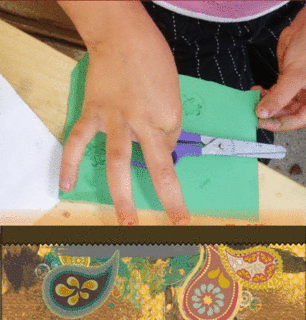Waldorf

Waldorf Philosophy
Waldorf education was founded by Rudolf Steiner (1861-1925), a maverick Austrian scientist and philosophical thinker. His interests intersected spiritual and scientific planes: he wanted to integrate these two forms of understanding and experience, and he founded "Anthroposophy". In 1919, in the wake of the devastation of World War I, Steiner was invited by Emil Mott to found a school for the employees of the Waldorf-Astoria cigarette factory in Stuttgart, Germany. The vision was that this new kind of school would educate human beings able to create a just and peaceful society. It defied the conventions of the time in being coeducational (bringing boys and girls together in the classroom), open to children of any background (without entrance examination), comprehensive (from preschool level through high school), and independent of external control (a self-governing administrative unit). [Author's Note—6/27/05: The original Waldorf school in Stuttgart began with first grade, not preschool. The first Waldorf early childhood program (kindergarten) was started later in another city.] The Waldorf Early Childhood Association of North America (WECAN) provides information and resources for interested early childhood educators and parents. Today, Waldorf education continues to be a well-defined model with every school administratively independent. There are now more than 800 Waldorf schools in over 40 countries, with 140 schools affiliated with the Association of Waldorf Schools of North America (AWSNA).
 Rudolf Steiner believed in a unity of
spirit, soul, and body, and that good education restores the balance
between thinking, willing, and feeling. His theory of
child development elaborated three cycles of seven-year stages, each
with its own distinctive needs for learning—an ascending spiral of
knowledge. Before age 7, nursery and kindergarten children learn through
imitation and doing. Imaginary play is
considered the most important "work" of the young child and the activity
through which the child grows physically, intellectually, and
emotionally. The educational focus is on bodily exploration,
constructive and creative play, and oral (never written) language,
story, and song. On a given morning, children might do such things as
sing songs, paint with watercolors, color with beeswax crayons, cook,
hear a story told with puppets, go on a nature walk, work in the garden,
build with wooden blocks, or make houses using play stands and cloth.
Through these activities, they become deeply engaged and develop powers
of concentration and motivation. A significant portion of the school
morning is devoted to uninterrupted imaginary play. Recognition of the
importance of "rhythm" and of balance of energetic and restful play
leads teachers to follow a cyclical schedule of yearly, weekly, and
daily activities, including festivals and foods. From 7 to 14 years,
children stay with the same teacher and classroom group, and they become
a very close-knit group as they explore the world through conscious
imagination or "feeling intelligence". The
teacher presents a curriculum that has structure and sequence but that
relies on lessons unaccompanied by textbooks. This approach fosters an
integrated, multi sensorial approach to learning and expression, with
more emphasis on oral listening and memory than is found in other early
childhood models for the primary years. For example, the teacher might
introduce an arithmetical operation by telling a story where the numbers
are characters in a drama or render the history of the Norman Conquest
as an exciting tale. Children listen as the teacher presents the
material, and they integrate what they have learned as they design and
illustrate with care and beauty their own lesson books. In essence, they
compose their own texts, which preserve for them what they have learned
in their own personal format, documents and treasures of their learning
experiences. Children study literature, folktales, and mythology;
rhythmic musical movement (eurythmy); practical crafts; natural
sciences; foreign languages; art; and music. Out of doors, they may
construct play shelters with boards, branches, and other materials.
Rudolf Steiner believed in a unity of
spirit, soul, and body, and that good education restores the balance
between thinking, willing, and feeling. His theory of
child development elaborated three cycles of seven-year stages, each
with its own distinctive needs for learning—an ascending spiral of
knowledge. Before age 7, nursery and kindergarten children learn through
imitation and doing. Imaginary play is
considered the most important "work" of the young child and the activity
through which the child grows physically, intellectually, and
emotionally. The educational focus is on bodily exploration,
constructive and creative play, and oral (never written) language,
story, and song. On a given morning, children might do such things as
sing songs, paint with watercolors, color with beeswax crayons, cook,
hear a story told with puppets, go on a nature walk, work in the garden,
build with wooden blocks, or make houses using play stands and cloth.
Through these activities, they become deeply engaged and develop powers
of concentration and motivation. A significant portion of the school
morning is devoted to uninterrupted imaginary play. Recognition of the
importance of "rhythm" and of balance of energetic and restful play
leads teachers to follow a cyclical schedule of yearly, weekly, and
daily activities, including festivals and foods. From 7 to 14 years,
children stay with the same teacher and classroom group, and they become
a very close-knit group as they explore the world through conscious
imagination or "feeling intelligence". The
teacher presents a curriculum that has structure and sequence but that
relies on lessons unaccompanied by textbooks. This approach fosters an
integrated, multi sensorial approach to learning and expression, with
more emphasis on oral listening and memory than is found in other early
childhood models for the primary years. For example, the teacher might
introduce an arithmetical operation by telling a story where the numbers
are characters in a drama or render the history of the Norman Conquest
as an exciting tale. Children listen as the teacher presents the
material, and they integrate what they have learned as they design and
illustrate with care and beauty their own lesson books. In essence, they
compose their own texts, which preserve for them what they have learned
in their own personal format, documents and treasures of their learning
experiences. Children study literature, folktales, and mythology;
rhythmic musical movement (eurythmy); practical crafts; natural
sciences; foreign languages; art; and music. Out of doors, they may
construct play shelters with boards, branches, and other materials.
The Waldorf teacher generally plays a performance role in the classroom as he or she leads or models many whole-group activities involving integration of the academic and the artistic with an explicit spirituality. The teacher is also a didactic moral leader, seeking to provide an intimate classroom atmosphere permeated with a sense of harmony and full of themes about caring for the community and for the natural and living worlds. The teacher needs a classroom in which children can bring together their thinking, feeling, and willing, no matter what their personalities and temperaments. Color and the use of natural materials and carefully chosen props (such as open-ended, handmade toys and dolls with minimal detail to encourage the imagination) are intrinsic to the uncluttered, warm and homelike, aesthetically pleasing Waldorf environments. Teachers seek to encourage the child's natural sense of wonder, belief in goodness, and love of beauty. They are more reticent at the early childhood levels of Waldorf.






